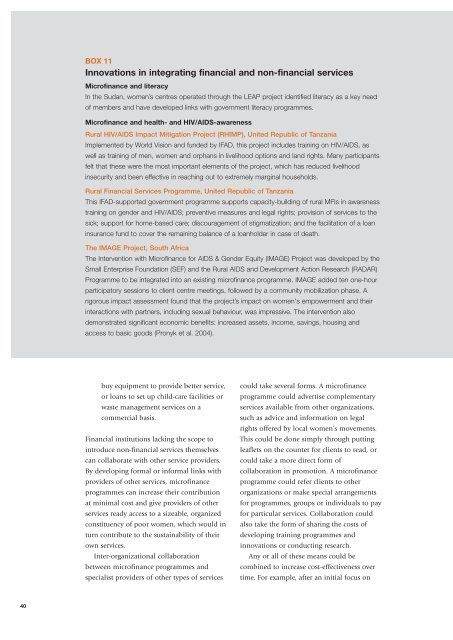Reaching and empowering women - Genfinance
Reaching and empowering women - Genfinance
Reaching and empowering women - Genfinance
You also want an ePaper? Increase the reach of your titles
YUMPU automatically turns print PDFs into web optimized ePapers that Google loves.
BOX 11<br />
Innovations in integrating financial <strong>and</strong> non-financial services<br />
Microfinance <strong>and</strong> literacy<br />
In the Sudan, <strong>women</strong>’s centres operated through the LEAP project identified literacy as a key need<br />
of members <strong>and</strong> have developed links with government literacy programmes.<br />
Microfinance <strong>and</strong> health- <strong>and</strong> HIV/AIDS-awareness<br />
Rural HIV/AIDS Impact Mitigation Project (RHIMP), United Republic of Tanzania<br />
Implemented by World Vision <strong>and</strong> funded by IFAD, this project includes training on HIV/AIDS, as<br />
well as training of men, <strong>women</strong> <strong>and</strong> orphans in livelihood options <strong>and</strong> l<strong>and</strong> rights. Many participants<br />
felt that these were the most important elements of the project, which has reduced livelihood<br />
insecurity <strong>and</strong> been effective in reaching out to extremely marginal households.<br />
Rural Financial Services Programme, United Republic of Tanzania<br />
This IFAD-supported government programme supports capacity-building of rural MFIs in awareness<br />
training on gender <strong>and</strong> HIV/AIDS; preventive measures <strong>and</strong> legal rights; provision of services to the<br />
sick; support for home-based care; discouragement of stigmatization; <strong>and</strong> the facilitation of a loan<br />
insurance fund to cover the remaining balance of a loanholder in case of death.<br />
The IMAGE Project, South Africa<br />
The Intervention with Microfinance for AIDS & Gender Equity (IMAGE) Project was developed by the<br />
Small Enterprise Foundation (SEF) <strong>and</strong> the Rural AIDS <strong>and</strong> Development Action Research (RADAR)<br />
Programme to be integrated into an existing microfinance programme. IMAGE added ten one-hour<br />
participatory sessions to client centre meetings, followed by a community mobilization phase. A<br />
rigorous impact assessment found that the project’s impact on <strong>women</strong>'s empowerment <strong>and</strong> their<br />
interactions with partners, including sexual behaviour, was impressive. The intervention also<br />
demonstrated significant economic benefits: increased assets, income, savings, housing <strong>and</strong><br />
access to basic goods (Pronyk et al. 2004).<br />
buy equipment to provide better service,<br />
or loans to set up child-care facilities or<br />
waste management services on a<br />
commercial basis.<br />
Financial institutions lacking the scope to<br />
introduce non-financial services themselves<br />
can collaborate with other service providers.<br />
By developing formal or informal links with<br />
providers of other services, microfinance<br />
programmes can increase their contribution<br />
at minimal cost <strong>and</strong> give providers of other<br />
services ready access to a sizeable, organized<br />
constituency of poor <strong>women</strong>, which would in<br />
turn contribute to the sustainability of their<br />
own services.<br />
Inter-organizational collaboration<br />
between microfinance programmes <strong>and</strong><br />
specialist providers of other types of services<br />
could take several forms. A microfinance<br />
programme could advertise complementary<br />
services available from other organizations,<br />
such as advice <strong>and</strong> information on legal<br />
rights offered by local <strong>women</strong>’s movements.<br />
This could be done simply through putting<br />
leaflets on the counter for clients to read, or<br />
could take a more direct form of<br />
collaboration in promotion. A microfinance<br />
programme could refer clients to other<br />
organizations or make special arrangements<br />
for programmes, groups or individuals to pay<br />
for particular services. Collaboration could<br />
also take the form of sharing the costs of<br />
developing training programmes <strong>and</strong><br />
innovations or conducting research.<br />
Any or all of these means could be<br />
combined to increase cost-effectiveness over<br />
time. For example, after an initial focus on<br />
40

















